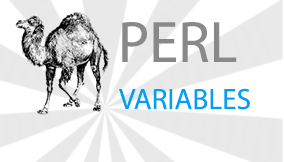Summary: in this tutorial, you’ll learn about Perl variables, variable scopes, and variable interpolation.

To manipulate data in your program, you use variables.
Perl provides three types of variables: scalars, lists, and hashes to help you manipulate the corresponding data types including scalars, lists, and hashes.
You’ll focus on the scalar variable in this tutorial.
Naming variables
You use scalar variables to manipulate scalar data such as numbers and strings.
A scalar variable starts with a dollar sign ($), followed by a letter or underscore, after that, any combination of numbers, letters, and underscores. The name of a variable can be up to 255 characters.
Perl is case-sensitive. The $variable and $Variable are different variables.
Perl uses the dollar sign ( $) as a prefix for the scalar variables because of the $ looks like the character S in the scalar. You use this tip to remember when you want to declare a scalar variable.
The following example illustrates valid variables:
$gate = 10;
$_port = 20;Code language: Perl (perl)However, the following variables are invalid in Perl.
$4whatever = 20; # no letter or underscore found after dollar sign ($)
$email-address = "[email protected]"; # special character (-) found
$home url = "http://localhost/perltutorial"; # space is not allowedCode language: Perl (perl)Declaring variables
Perl doesn’t require you to declare a variable before using it.
For example, you can introduce a variable in your program and use it right away as follows:
$a = 10;
$b = 20;
$c = $a + $b;
print($c);Code language: Perl (perl)In some cases, using a variable without declaring it explicitly may lead to problems. Let’s take a look at the following example:
$color = 'red';
print "Your favorite color is " . $colour ."\n";Code language: Perl (perl)The expected output was Your favorite color is red.
However, in this case, you got Your favorite color is, because the $color and $colour are different variables. The mistake was made because of the different variable names.
To prevent such cases, Perl provides a pragma called strict that requires you to declare variable explicitly before using it.
In this case, if you use the my keyword to declare a variable and try to run the script, Perl will issue an error message indicating that a compilation error occurred due to the $colour variable must be declared explicitly.
#!/usr/bin/perl
use strict;
my $color = 'red';
print "Your favorite color is " . $colour ."\n"Code language: Perl (perl)A variable declared with the my keyword is a lexically scoped variable.
It means the variable is only accessible inside the enclosing block or all blocks nested inside the enclosing block. In other words, the variable is local to the enclosing block.
Now, you’ll learn a very important concept in programming called variable scopes.
Perl variable scopes
Let’s take a look at the following example:
#!/usr/bin/perl
use warnings;
$color = 'red';
print("my favorite #1 color is " . $color . "\n");
# another block
{
my $color = 'blue';
print("my favorite #2 color is " . $color . "\n");
}
# for checking
print("my favorite #1 color is " . $color . "\n");Code language: Perl (perl)In the example above:
- First, declared a global variable named
$color. - Then, displayed the favorite color by referring to the
$colorvariable. As expected, we get the red color in this case. - Next, created a new block and declared a variable with the same name
$colorusing themykeyword. The$colorvariable is lexical. It is a local variable and only visible inside the enclosing block. - After that, inside the block, we displayed the favorite color and we got the
bluecolor. The local variable takes priority in this case. - Finally, following the block, we referred to the
$colorvariable and Perl referred to the$colorglobal variable.
If you want to declare global variables that are visible throughout your program or from external packages, you can use our keyword as shown in the following code:
our $color = 'red';Code language: Perl (perl)Perl variable interpolation
Perl interpolates variables in double-quoted strings. It means if you place a variable inside a double-quoted string, you’ll get the value of the variable instead of its name.
Let’s take a look at the following example:
#!/usr/bin/perl
use strict;
use warnings;
my $amount = 20;
my $s = "The amount is $amount\n";
print($s);Code language: Perl (perl)Perl interpolates the value of $amount into the string which is 20.
Note that Perl only interpolates scalar variables and arrays, not hashes. In addition, the interpolation is only applied to the double-quoted string, but not the single-quoted string.
In this tutorial, you have learned about Perl variables including naming and declaring scalar variables. You’ve also learned about variable scopes and variable interpolation.